What is a Cable Railing?
Cable railing is a railing with cables as infill. Cable railing can be installed as a new installation or as a remodel of an existing system.AGS Stainless designs and manufactures the Rainier cable railing system under the Clearview® brand.
Table of Contents
- Section 1: Cable Railing Infill
- Section 2: Cable Railing Post Materials
- Section 3: Cable Railing System Handrails
- Section 4: Cable Railing Finishes
- Section 5: Cable Railing Ideas and Design Trends
- Section 6: Cable Railing Applications
- Section 7: Cable Railing Hardware and Accessories
- Section 8: Cable Railing Installation
- Section 9: Cable Railing Code and Regulations
- Section 10: Cable Railing Prefabrication
Schedule a FREE DESIGN CONSULTATION or continue reading to learn more about cable railing infill, cable railing post materials, cable railing system handrails, cable railing finishes, cable railing applications, cable railing ideas and design trends, cable railing hardware and accessories, cable railing installation, cable railing code and regulations, and cable railing prefabrication.
1. Cable Railing Infill Can Be Horizontal or Vertical
Infill describes the parts of a cable railing system between vertical posts and below a horizontal handrail. These stainless steel cable railing parts can be either horizontal or vertical. The horizontal variant is more popular but the vertical cable rail has a great look.
Horizontal Cable Infill
Vertical Cable Infill
Hybrid Infill
Horizontal cable railing systems usually have cables attached to the posts. This configuration creates clean lines that practically disappear into the background offering a seemingly unobstructed view.
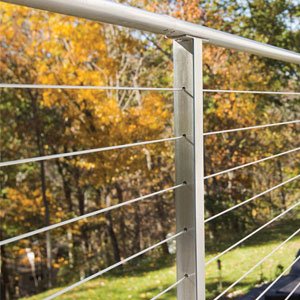
Two horizontal rails attach cables on a vertical cable railing kit or system. Vertical stainless steel cable railing systems used to be relatively rare due to a slightly higher cost. However, a vertical cable rail system is now a common design element for creating a distinctive look. A stainless steel railing cable usually use 1/8" diameter cable. DIY vertical cable railing systems require simple tools like AGS - Cable Cutters and AGS - Cable Crimpers to perform the installation.

Hybrid Infill with a mix of glass panels and stainless steel cables is an alternative to cable railing systems with only cable infill.

2. The Pros and Cons of Cable Railing Post Materials
Plastic, wood, aluminum, or stainless steel cable rail posts are vertical components. These components support the railing system with stainless steel fittings attached to support the horizontal cable infill.
Plastic or Composite
Wood
Aluminum
Stainless Steel

A plastic or composite post and cable railing system would be low-maintenance because plastic doesn't corrode or rot. Plastic cable railing posts also come in many different colors. When subjected to ultraviolet (UV) rays from the sun the plastic can dull and the color fade. Plastics can also start soften on summer days and might eventually become brittle enough to crack in the winter. When it comes to railing post materials, you get what you pay for, and plastic will always feel cheap.
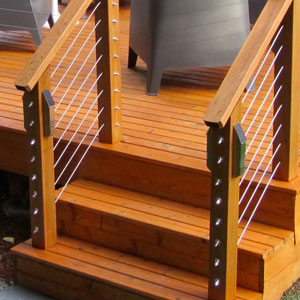
A stainless steel cable railing with wood posts gets the job done. Wood posts with stainless steel hardware provide a reasonably priced cable rail system. Since wood is a renewable resource and stainless steel cables are 100% recyclable, a wood and cable railing system is better for the environment. Cable railing wood posts are often recommended for interior applications because moisture can cause rot when used on the exterior. Exterior wood and cable stair railing system posts require a chemical preservative to resist rot.

Aluminum posts for cable railing systems may seem like a way to cut costs. However, an aluminum cable railing system is a terrible long-term investment. Take metal deck posts for cable railing systems as an example. Painted aluminum cable railing systems for decks initially look almost as sleek as stainless steel systems. Aluminum is a softer metal that acquires scratches and dents over time. Scratches and dents on aluminum metal posts for cable railing systems cause paint to chip. Parts of aluminum metal cable railing systems without paint can become corroded. As a long term investment stainless steel is a better choice.

Stainless steel cable railing systems are stunning. AGS stainless steel cable railing kits and systems are composed of components. A stainless steel cable railing kit or system with a component-based design simplifies on-site installation with no on-site cutting or welding required.
One-piece stainless steel posts for cable railing systems are unique to AGS Stainless. These stainless steel cable railing posts have welded base plate and handrail attachment points. The posts are predrilled for mounting hardware or threading cable.
Stainless cable railing systems made with marine grade 316 stainless steel offer superior corrsion resistance. The marine grade 316 stainless steel cable railing cost per foot is higher than 304 stainless steel, but you are paying more for quality.
This corrosion resistance allows stainless steel cable rail systems to have additional finish options like brushed or powder coat. Non-powder coated stainless cable rail systems require periodic passivation with an AGS - Stainless Steel Cleaning & Maintenance Kit.
In the end, there is no perfect solution, but a stainless cable railing system checks most of the boxes for what you would want in a material.
3. Cable Railing System Handrails Come in Many Styles
Cable railing system handrails have several styles, which include round, flat, and wood. A custom handrail might have transitions for height and direction changes to form a continuous handrail.
Round Handrail
Flat Handrail
Wood Handrail
Straight Gooseneck Handrail Transition
Gooseneck Handrail Transition at 90 Degrees
Gooseneck Handrail Transition at 180 Degrees
Cable Railing Extensions and Returns
A round handrail is easy to grip and can add strong lines to contemporary interior designs.
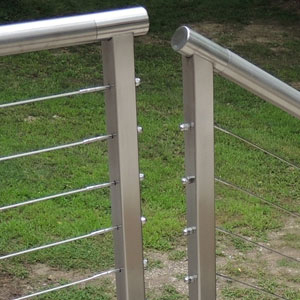
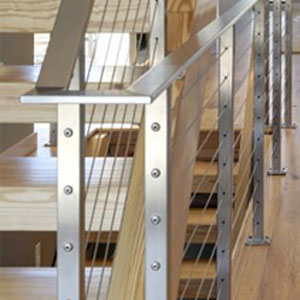
A flat handrail combined with cable infill produces clean lines that would be compatible with modern interior designs.
A wood handrail offers a balanced look for everything from rustic to farmhouse interior designs.
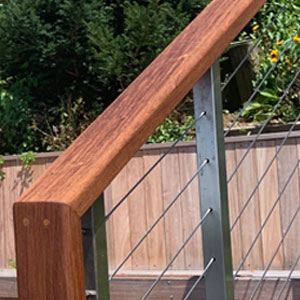
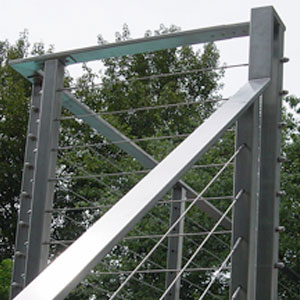
A straight gooseneck handrail transition is used when there is a change in height, but not a change in direction.
Dogleg stairs might have a cable railing with a gooseneck handrail transition at 90 degrees.
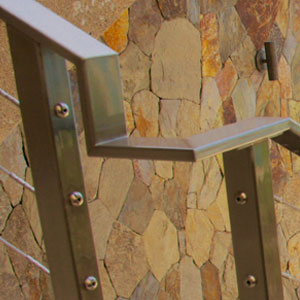
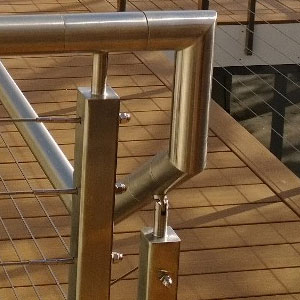

Switchback stairs could have a cable railing with a gooseneck handrail transition at 180 degrees.
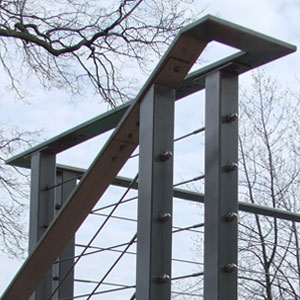


A cable railing extension and return describes when a handrail extends beyond a post and returns to a wall or a post.
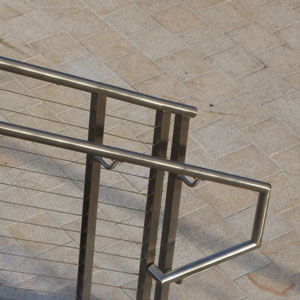

4. There Are Many Finishes to Consider for Cable Railing Systems
The most common finishes for cable railing systems include brushed, powder coat, and stained.
Brushed Finish
Powder Coat Finish
Stained Finish
Stainless steel with a brushed finish has a beautiful grain that runs in a single direction. Rub a Scotch-Brite® cleaning pad back and forth along this grain to remove any scratches.
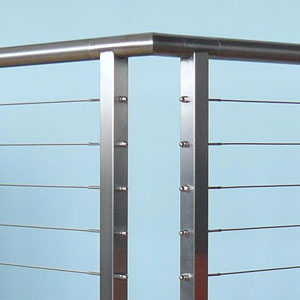
You could obtain a black cable railing look or a cable railing in any other color with a powder coat finish. Powder coating uses a dry powder that is electrostatically charged, sprayed onto a stainless steel surface, and then cured with heat. This process leaves behind an opaque finish with a smooth texture.
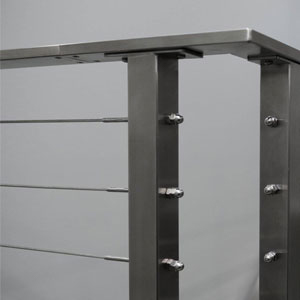
A stained finish could change the color of a cable railing system with wood posts and handrails. A stain is also translucent enough to maintain the natural beauty of the wood.

5. These Are Some of the Most Popular Cable Railing Ideas and Design Trends
Some cable railing design ideas include curved handrails, stem reducers, height extensions, gates, double posts, and corner posts. Check out this gallery with cable railing pictures for more ideas. Popular cable railing interior and exterior designs include modern, contemporary, rustic, and coastal.
Curved Cable Railing Option
Cable Railing Stem Reducer Option
Cable Railing Height Extension Option
Cable Railing Gate Option
Double Post Cable Railing Option
Corner Post Cable Railing Option
Modern Cable Railing Interior Design
Contemporary Cable Railing Interior Design
Rustic Cable Railing Exterior Design
Coastal Cable Railing Exterior Design
A curved cable railing is a custom option with curved handrails, curved cables, and straight posts. Some cable railing applications for a curved handrail include decks, patios, and balconies. Stainless steel cables are flexible enough to bend on their own. However, a particular machine is required to bend stainless steel handrails into the desired shapes.
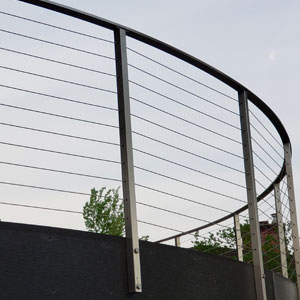
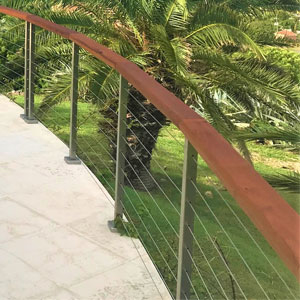
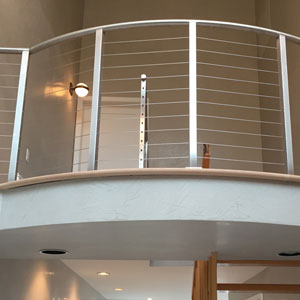
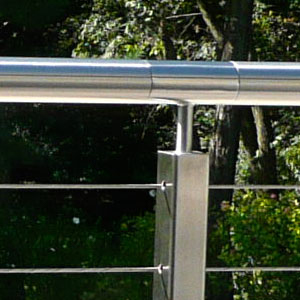
A stem reducer describes when a part of a post cap becomes smaller between a handrail and a post. Post caps with stem reducers can be placed on the tops of wood posts or welded to the tops of stainless steel posts.
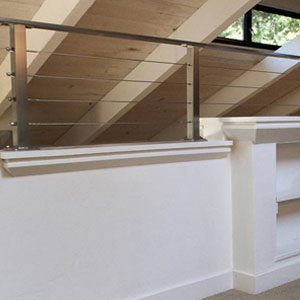
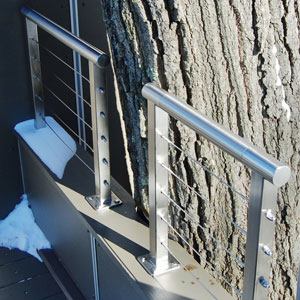
A cable railing height extension is a short railing mounted on top of a barrier to help keep people safe and meet requirements for complying with the Code. You could replace a short barrier with a taller barrier. However, installing a height extension on top of a solid barrier minimizes obstruction of a view.
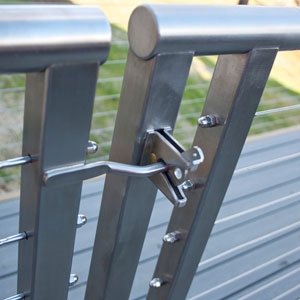
A cable railing gate has hinges and a latch. Having a cable rail gate can help keep children or pets safe.
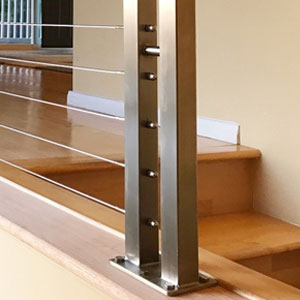
A cable railing might have a double post at the end of a run to meet Code and improve stability. Double posts may be required for commercial projects.

A spreader bar might be required on a cable railing corner post assembly between runs with direction changes to meet Code or improve stability.
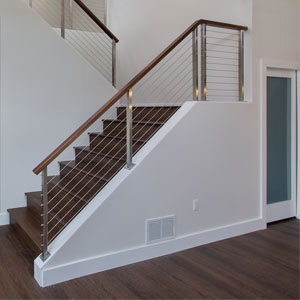
Modern cable railing designs might use horizontal infill to create clean lines and a wood handrail to add warmth.
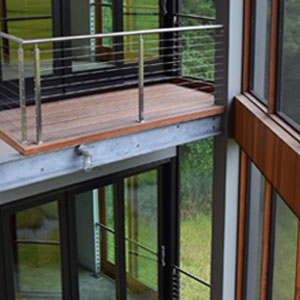
Contemporary interior cable railing systems strike a balance between form and function by promoting safety with a sense of style.

A rustic cable railing might have a dark gray powder coat for adding drama while cable infill produces visual interest next to course raw materials like wood.

A coastal cable railing disappears into the background to present a clear view of sparkling blue water and white sand beaches.
6. Cable Railing Applications Are Practically Endless
Cable railing applications could include commercial, residential, stairs, balconies, decks, patios, porches, gardens, pools, and docks.
Commercial Cable Railing
Residential Cable Railing
Cable Stair Railing
Cable Deck Railing
Cable Patio Railing
Cable Balcony Railing
Cable Porch Railing
Cable Garden Railing
Cable Pool Railing
Cable Dock Railing
An architectural cable railing system for a commercial project must be 42-inches tall and might have additional handrails to meet Code.
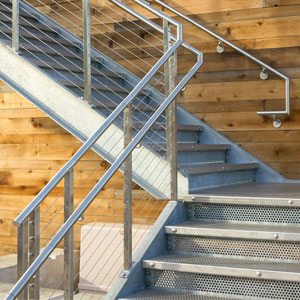
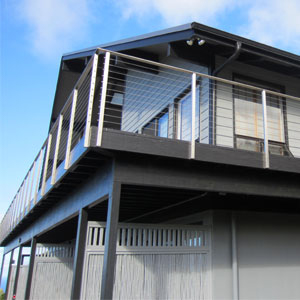
Residential cable railing systems must be at least 36-inches tall to meet Code and may need to be 42-inches tall to comply with local regulations.
A stair cable railing system pairs well with a variety of designs. For example, interior cable stair railing kits or systems add visual interest throughout a building. Having a cable railing staircase as a focal point could completely change an interior. On the other hand, a cable staircase railing is minimalist and doesn't dominate a room. Your stainless steel cable stair railing cost estimate depends on additional design complexity, more Code requirements, and the potential need for custom components like gooseneck handrails.
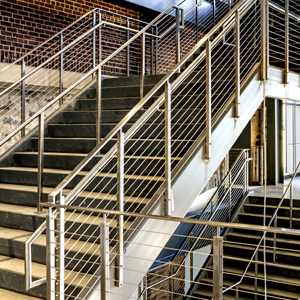
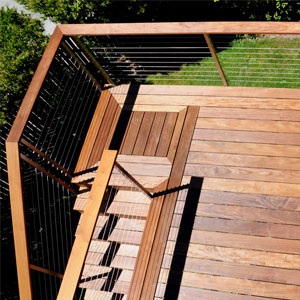
A wood deck with cable railing systems should be appreciated. Looking at a deck railing with cable infill will bring pleasure every day. Stainless steel cable deck railing systems are incredibly durable. Each stainless steel cable for deck railing systems is electropolished for superior corrosion resistance. Since stainless steel cable railing systems for decks only require periodic maintenance, you will be able to spend more time enjoying your spectacular view. Stairs are often a significant part of deck designs with cable railing systems. However, the cable deck railing cost could be higher with stairs.
A patio cable railing is sure to impress and ideal for entertaining guests.
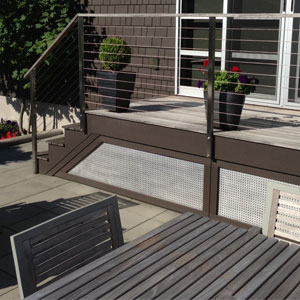
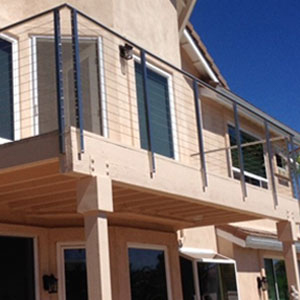
A balcony cable railing allows for a better view from a higher vantage point.
A cable porch railing system with curb appeal could allow you to sell a home faster for a higher price.
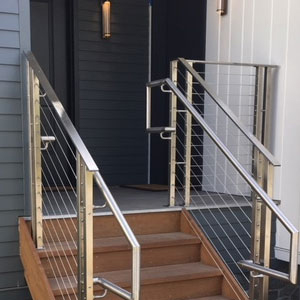

Outdoor cable railing systems around a garden allow you to avoid getting dirty or stepping on any plants while watering.
A cable railing around a pool keeps children safe by restricting access when adults aren't around to supervise them and looks great with a stained wood handrail.

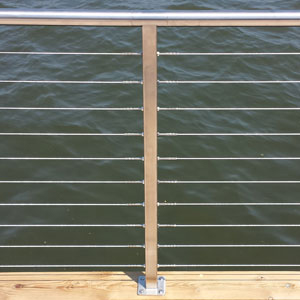
Exterior cable railing systems on a dock could provide the support you need while walking along the water.
7. Cable Railing Hardware and Accessories Are Available for Every Situation
A stainless steel cable rail hardware kit or system is composed of components. DIY cable railing hardware suppliers like AGS Stainless can provide custom designs with components that are ideal for your specific situation. If you ever need extra cable railing supplies, you can visit the AGS E-commerce store.
You might notice how not all cable railing prices are the same. Part of the cable railing pricing in your cost estimate will depend on your choice of fitting hardware.
Adjustable Deck Toggle Fitting Hardware
Adjustable Lag Terminal Fitting Hardware
Standard Cable Fitting Hardware
Flat Bearing Washer Hardware
Post Mounted Handrail Bracket Hardware
Wall Mounted Handrail Bracket Hardware
Base Plate Cover Hardware
Lag Screw Mounting Hardware
Concrete Anchor Mounting Hardware
Accent Light Accessories
A Clearview® - Deck Toggle - Adjustable is a stainless cable railing hardware option for wood posts and plastic posts. It attaches and tensions an uncoated 1/8-in stainless steel Clearview® - Cable for railing posts made of wood or plastic. These stainless cable railing fittings require crimping with AGS - Cable Crimpers.
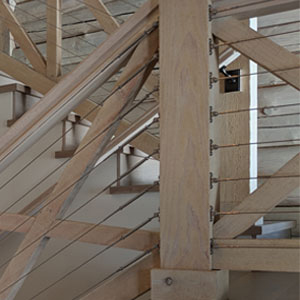
A Clearview® - Lag Terminal - Adjustable is another option to consider when looking at stainless steel cable railing hardware for wood posts or plastic posts. It attaches and tensions an uncoated 1/8-in stainless railing cable like the Clearview® - Cable to a wood or plastic post. These stainless steel cable railing fittings do not require crimping.

A Clearview® - Standard Cable Fitting is an inexpensive cable railing hardware option for wood, plastic, or stainless steel posts. They are cheap cable railing fittings for attaching uncoated 1/8-in stainless steel Clearview® - Cables to stainless steel posts. Two wrenches for tightening the nuts are necessary to tension the runs. These cable railing end fittings require crimping with AGS - Cable Crimpers.
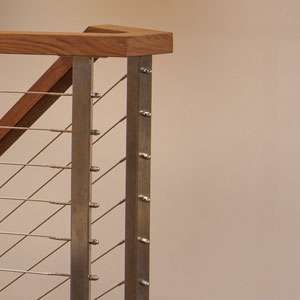
A Clearview® - Standard Cable Fitting on a wood post might need additional railing cable hardware like a Clearview® - Flat Bearing Washer.
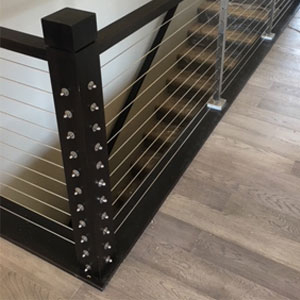
A handrail bracket can mount a round handrail on a post. You could use a rubber Clearview® - Handrail Bracket - Insert to mount a flat handrail and prevent scratches on the stainless steel bracket.
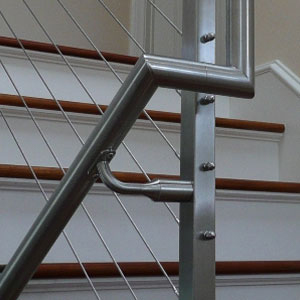
A Clearview® - Handrail Bracket - Wall Mounted mounts a round handrail on a stainless steel post.

A base plate cover conceals mounting hardware and a welded base plate on a stainless steel railing system.
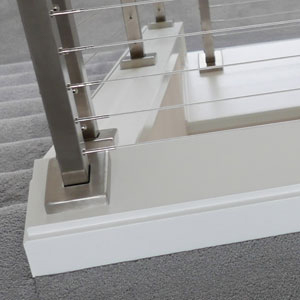
Clearview® - Lag Screws are the best cable deck railing hardware for attaching a stainless steel post on a railing system to a wood mounting surface like a deck.
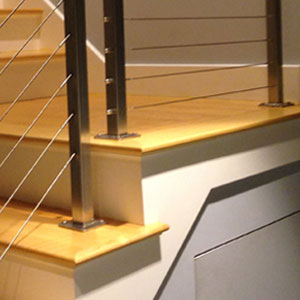
A Clearview® - Concrete Expansion Anchor attaches a stainless steel post for a railing system to a concrete mounting surface like a patio.

Cable rail lighting often refers to design elements that add visual interest. StarLight solar-powered LED accent lights can decorate a spectacular landscape, path, garden, or driveway by mounting on a garden stake or complement a beautiful railing system on a deck, patio, stairway, balcony, porch, or veranda.
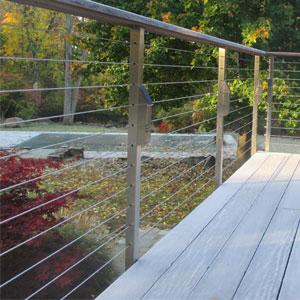
8. Performing a Cable Railing Installation on Your Own is Much Cheaper
The cost to install cable railing systems will depend on the availability of labor in your area. You could hire local cable railing installers to perform the work. Alternatively, a do it yourself cable railing installation is a great way to save money on labor costs. For example, if you install a DIY interior cable railing kit or system, you won't even need to hire a contractor.
Additionally, DIY cable railing systems are often composed of components. The components for exterior or interior cable railing kits and systems eliminate the need for on-site welding, cutting, grinding, and finishing. In contrast, components for a DIY cable railing system are faster and safer to install with screws.
Installing cable railing systems is easy with these step-by-step instructions. However, before getting started, you should be familiar with DIY installation techniques and mounting methods.
How-To Video: How to Install Stainless Steel Cable Railing Systems
How-To Video: How to Tighten Cable Railing Nuts and Tension the Cables
How-To Video: How to Build Cable Deck Railing Systems with Stainless Steel Posts
How-To Video: How to Install Cable Railing Systems with Wood Posts
Top Mounting Method
Side Mounting Method
This video shows how to make a cable railing system called Rainier. It also demonstrates cable railing DIY techniques like tightening a Clearview® - Barrel Nut Assembly with an L-wrench.
This video demonstrates cable stair railing DIY techniques for Rainier. For example, to tension cable railing system infill, start with the outer Clearview® - Cables on a run and alternate when tightening the nuts. DO NOT OVERTIGHTEN!
This video demonstrates how to install cable deck railing systems like Rainier. There are also deck cable railing do it yourself tips. For example, one cable deck railing DIY tip involves mounting stainless steel posts with Clearview® - Lag Screws.
This video demonstrates how to build a cable railing system with wood posts.
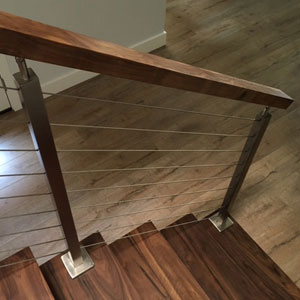
A top mount is when a cable railing is on top of a flat surface.

A side mount cable railing post could be on the side of a step while a side fascia mount cable railing might be on the side of a deck.
9. Cable Railing Systems Must Comply with Code and Regulations
Outdoor or indoor cable railing systems designed by AGS Stainless comply with the standards below. Designers can also work with you or your contractor to meet local codes in your area.
International Building Code (IBC)
International Residential Code (IRC)
American Disabilities Act (ADA)
The International Code Council (ICC) developed the IBC to ensure that commercial cable railing projects would adhere to public health and safety standards.
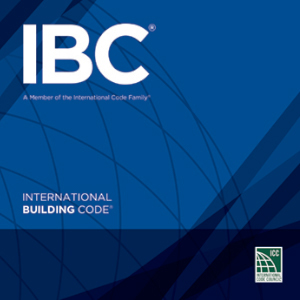

The International Code Council (ICC) developed the IRC to ensure that residential cable railing projects would adhere to public health and safety standards.
The United States Congress enacted the ADA in 1990 to ensure that walking surfaces, ramps, and stairs would be more accessible to people with disabilities.
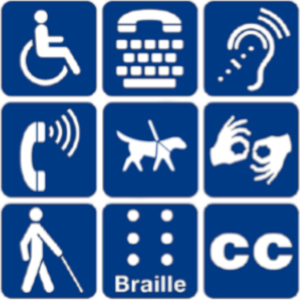
10. Cable Railing Prefabrication Cuts Costs
Prefabrication makes Rainier the best cable railing system that you can buy today. When advanced manufacturing processes like computer-aided design (CAD), fiber laser cutting, and tungsten inert gas (TIG) welding are performed off-site in a controlled factory setting, that idea is called prefabrication.
Less labor is required to perform the installation with prefabrication because most of the work is already complete when the components arrive on-site. After considering unpredictable variable costs for highly skilled on-site labor, cable railing systems cost less overall when artisans manufacture the components off-site.
Computer-Aided Design (CAD)
Fiber Laser Cutting
A fiber laser cutting machine uses lasers for precisely cutting stainless steel components to an accuracy level of 4/1000ths of an inch. This machine ensures a higher standard of quality in a fraction of the time that it would take with a computer-numerical control (CNC) machine.
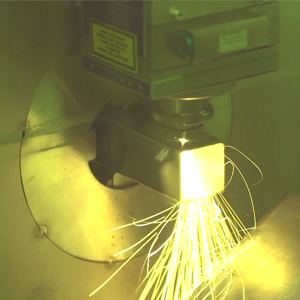
Laser Cutting at AGS Factory TIG Welding
Metal inert gas (MIG) welding completed by robots can't match the beauty of tungsten inert gas (TIG) welding performed by artisans with several years of experience.
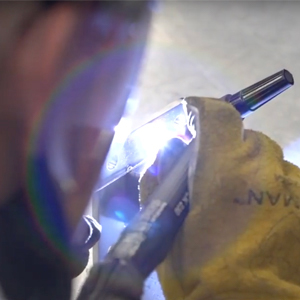
TIG Welding at AGS Factory 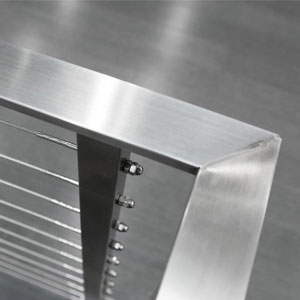
Cable Rail with Weld by AGS Stainless Factory-Direct Shipping
CAD is design software for creating drawings that are exact to the last cable railing detail. A CAD drawing with all of the necessary cable railing details only takes a few short weeks. Each one is based on your measurements to meet cable railing specifications. Other cable railing manufacturers might not have CAD capabilities. Not using CAD could limit their ability to design custom solutions.
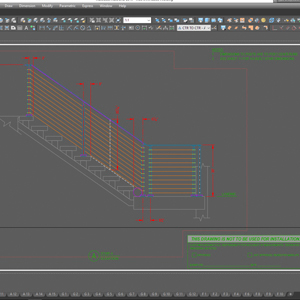
Prefabricated cable railing kits or systems can be composed of stainless steel components. These DIY stainless steel cable railing components are carefully packaged and shipped directly from the AGS factory. With other manufacturers, much of the cable railing cost is the result of markups from dealers or distributors. On the other hand, cable railing costs will be lower with a factory-direct supplier that sells directly to the consumer.

Why Buy a Cable Railing from AGS Stainless?
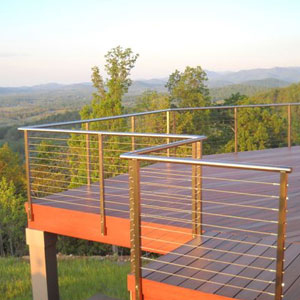
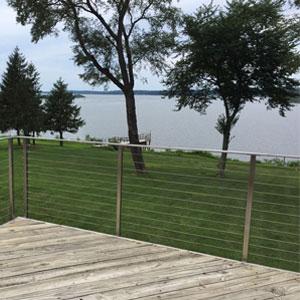

After you submit a simple drawing with basic measurements and any relevant photos, a dedicated design consultant will work with you or your contractor to discuss options, expectations, applications, budget, time frame, constraints, compliance, and maintenance. Design decisions determined at this point include measurements, handrail, infill, finish, mount, and any stair specifics. Then your design consultant develops a detailed cost estimate for your consideration at no cost to you.
Once you have approved the cost estimate for your railing system, a specially trained designer establishes a working relationship with you or your contractor to go over every detail. After that, your designer creates exact computer-aided design (CAD) drawings to ensure that you receive your desired look with a perfect on-site fit.
After you've approved your final CAD drawing, the fabrication process can begin. Meticulous planning allows the components to be fabricated off-site, which improves quality and simplifies the installation process. The fabrication team at the AGS factory brings expertise built on years of experience to perform fiber laser cutting, tungsten inert gas (TIG) welding, and finishing for the components before they are carefully packaged and shipped directly to you.
Schedule a FREE DESIGN CONSULTATION to get started.

